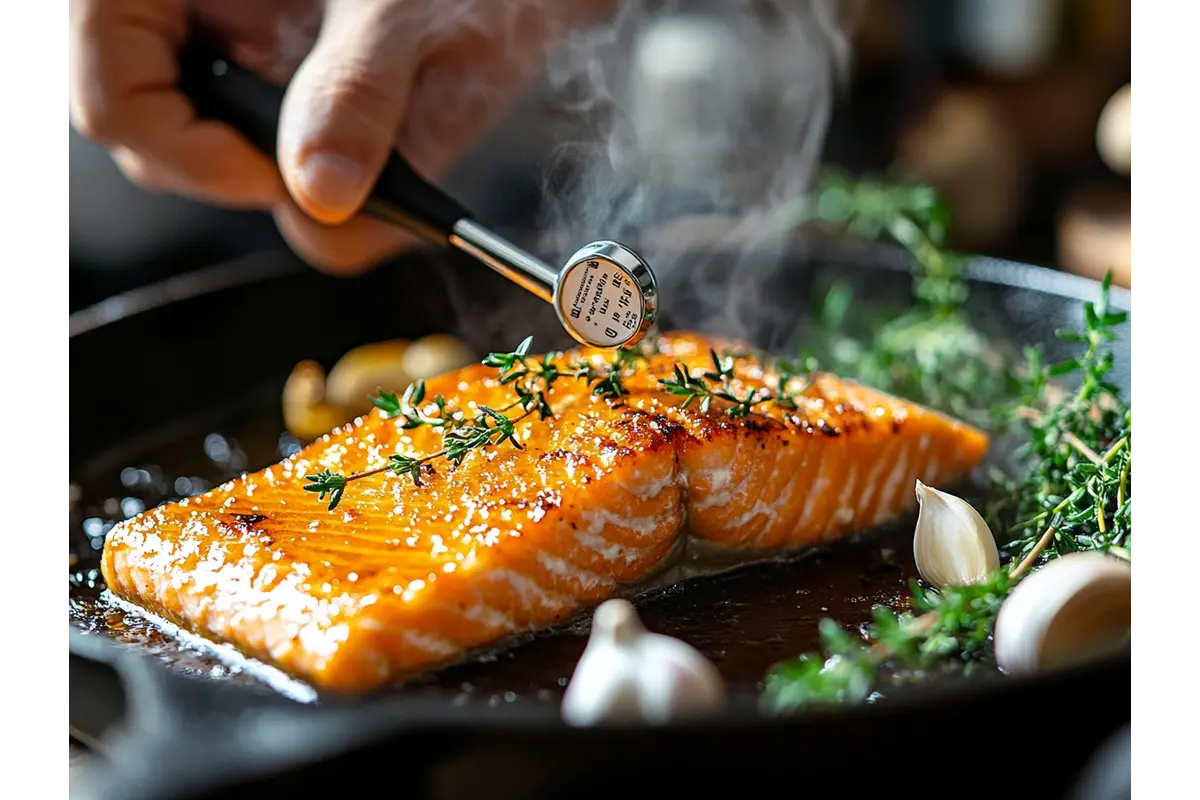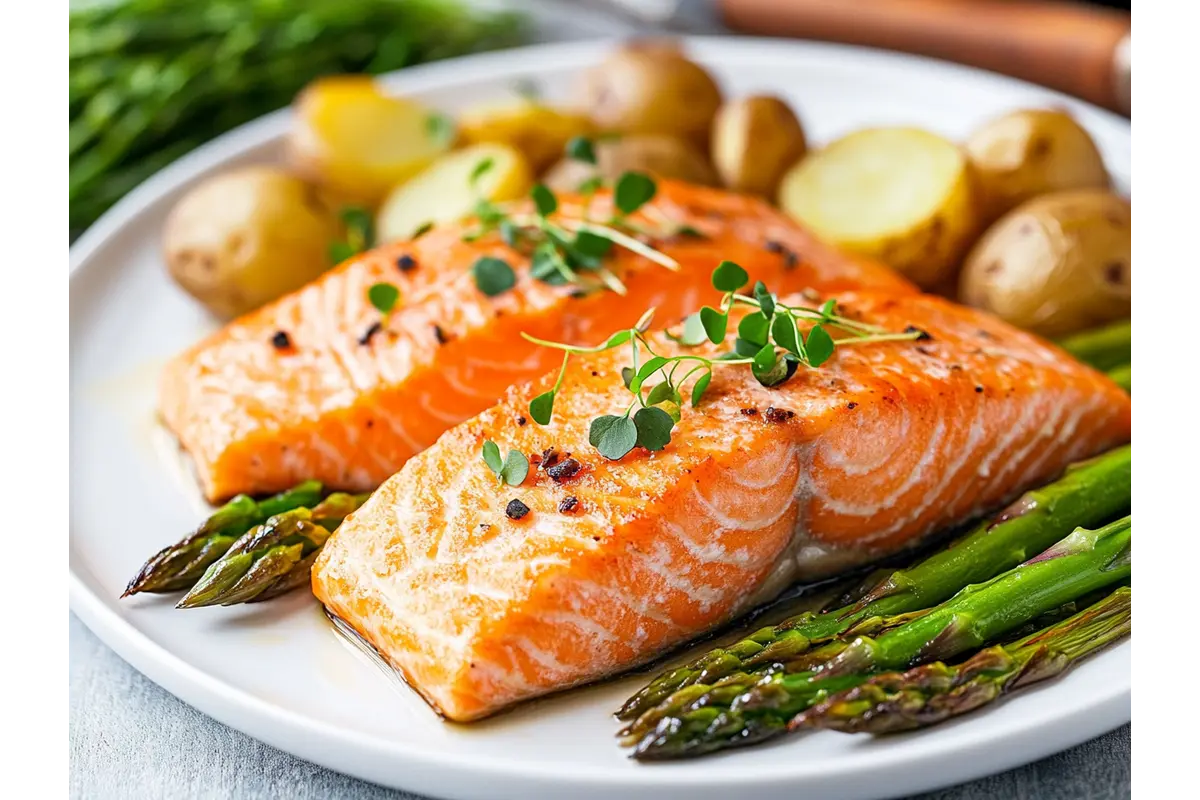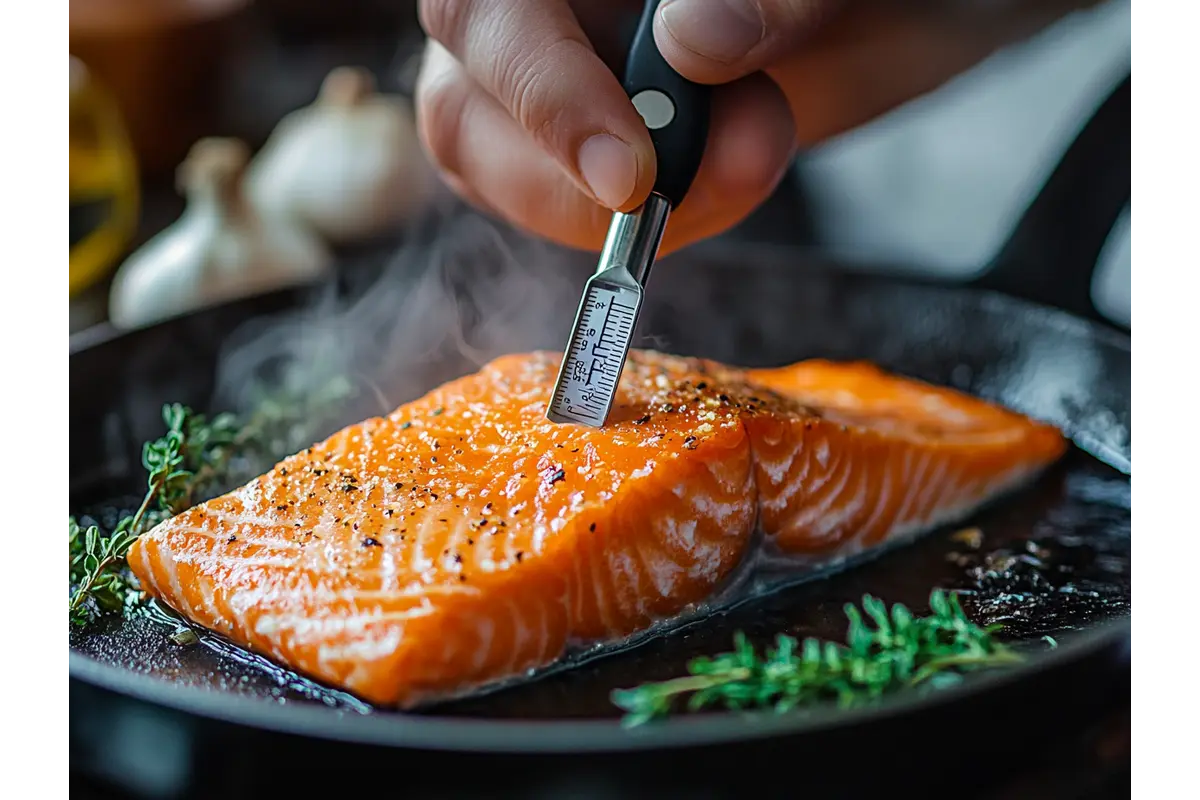When cooking salmon, you might wonder if it’s safe to eat at 130 degrees. The answer is yes, but knowing the safe cooking temperature is key. This ensures your meal is both tasty and safe. The FDA suggests eating at least eight ounces of fish weekly, and salmon is a great choice because it’s low in saturated fat and high in omega-3s.
Cooking salmon to 145°F, as the FDA advises, can make it dry and tasteless. But, cooking it to 120°F to 125°F can make it more enjoyable and safe. So, can you eat salmon at 130 degrees? Yes, but it’s not the best temperature. Knowing the right cooking temperature for salmon is important for a great dish.
Table of Contents
Understanding Safe Salmon Temperature Basics
Cooking salmon right is key to a tasty and safe meal. The FDA says to cook salmon to 145°F to keep it safe. This kills off harmful bacteria.
It’s not just about hitting a temperature. You also need to keep it there for a bit. The USDA says to cook salmon to at least 145°F. But, some say cooking it to 120°F to 125°F can be safe and taste better. Always check the salmon’s internal temperature to be sure.
To get it just right, follow these internal cooking temperatures for salmon:
- Rare: 120°F
- Medium rare: 125°F
- Medium: 130°F
- Medium well: 135-140°F
- Well done: 140-145°F
Can You Eat Salmon at 130 Degrees?
Cooking salmon right is key for food safety. The USDA says to cook it to 145°F. But, some like it cooked to 130 degrees. So, can you eat salmon at 130 degrees? Yes, but it depends on the salmon type and how you cook it.
Cooking salmon to 125°F can kill most bacteria, but it takes longer than 145°F. The salmon cooking temperature is very important for safety and quality. If you cook it to 130 degrees, make sure it reaches at least 125°F to avoid foodborne illness.
Here are some key points to consider when cooking salmon to 130 degrees:
- Cooking time and temperature are key for food safety
- The type of salmon and cooking method can affect the final temperature
- Using an instant-read thermometer can help ensure accurate temperature readings
Understanding how salmon cooking temperature and salmon internal temperature work can help. You can enjoy your salmon at 130 degrees safely. Always prioritize food safety and handle your salmon right for a healthy meal.
The Role of Time and Temperature in Salmon Safety
Cooking salmon right is key to keeping it safe to eat. The safe cooking temperature for salmon is not just about the temperature. It’s also about how long you cook it. The USDA says to cook salmon to 145°F to avoid foodborne illnesses.
The time and temperature together are very important for salmon safety. Cooking it to 125°F makes it medium-rare, which is lower than meat’s usual medium-rare. Pasteurization points for salmon are also key, as they can stop bacteria growth. For example, cooking to 130°F can lower the risk of getting sick from food.
Here are some key points to consider when cooking salmon:
- Cooking salmon to an internal temperature of 145°F can help to ensure food safety
- Cooking salmon to 125°F is considered medium-rare
- Pasteurization points for salmon can affect the growth of bacteria
By knowing the time-temperature relationship and following safe cooking tips, you can make delicious and safe salmon dishes. Always check the salmon’s internal temperature to make sure it’s safe to eat.
| Internal Temperature | Doneness |
|---|---|
| 125°F | Medium-rare |
| 130°F | Medium |
| 145°F | Well-done |
Different Cooking Methods and Their Temperature Requirements
There are many ways to cook salmon, each with its own temperature needs. Knowing these is key to cooking salmon just right. Salmon cooking methods include baking, grilling, pan-frying, and poaching.
Each method has its own temperature needs. For instance, baking salmon at 425°F takes 7 to 9 minutes. But at 350°F, it takes 15 to 20 minutes. Cooking techniques like pan-frying and grilling need a hotter temperature, between 400°F to 500°F.
Here’s a quick guide to the temperature needs for different cooking methods:
| Cooking Method | Temperature | Cooking Time |
|---|---|---|
| Baking | 350°F – 425°F | 15 – 20 minutes |
| Grilling | 400°F – 500°F | 5 – 10 minutes |
| Pan-frying | 400°F – 500°F | 5 – 10 minutes |

By knowing the different salmon cooking methods and their temperature requirements, you can cook salmon perfectly. Whether you bake, grill, or pan-fry, the right cooking techniques and temperature are key to a delicious dish.
Quality and Freshness Factors When Cooking at Lower Temperatures
When cooking salmon at lower temperatures, the quality and freshness matter a lot. This ensures your meal is safe and tasty. It’s key to pick fresh and sustainable salmon for the best taste and texture.
Choosing sushi-grade salmon is important for freshness and taste. This type of salmon is frozen to kill parasites, making it safe. Fresh salmon is very perishable and needs careful storage to stay good.
Selecting the Right Salmon
To get the best quality and freshness, look for these in salmon:
- Look for salmon with a pleasant smell and firm texture
- Choose salmon with a vibrant color and shiny appearance
- Check the packaging for any damage or signs of leakage
Storage and Handling Tips
Keeping salmon fresh and quality is key. Store it in a sealed container at 40°F (4°C) or below. Handle it gently to avoid damage.
By following these tips, you can enjoy a tasty and safe meal. Always remember to store and handle salmon properly to keep its quality.
| Salmon Type | Optimal Cooking Temperature | Storage Duration |
|---|---|---|
| Sushi-grade salmon | 120-125°F | Refrigerate for up to 5 days, freeze for up to 3 months |
| Fresh salmon | 125-135°F | Refrigerate for up to 5 days, freeze for up to 3 months |
How to Accurately Measure Salmon Temperature
To keep food safe, it’s key to check the salmon’s internal temperature. Use an instant-read thermometer in the thickest part of the fish. This method gives you an accurate temperature measurement. It’s vital to know if your salmon is cooked right.
For salmon temperature measurement, the USDA says to aim for 145°F for well-done fish. But for medium, aim for 125 °F to 135 °F. Here’s how to do it:
- Insert the thermometer into the salmon’s thickest part
- Wait for the temperature to stabilize
- Check the temperature against the recommended internal temperature for your desired level of doneness
By following these steps and using an instant-read thermometer, you can make sure your salmon is cooked safely. Remember, accurate temperature measurement is key to enjoying a delicious and safe meal.

Health Risks and Benefits of Different Cooking Temperatures
Cooking salmon at the right temperature is key to avoiding salmon health risks and keeping its nutrients. The FDA says to cook salmon to 145°F to prevent foodborne illnesses. But, this can make the salmon dry and tasteless.
Cooking salmon at a lower temperature can keep it moist and full of flavor. Cook’s Illustrated suggests cooking farmed salmon at 125°F and wild salmon at 120°F. For medium salmon, aim for 135°F.
Here is a table summarizing the recommended cooking temperatures and times for salmon:
| Cooking Method | Temperature | Time |
|---|---|---|
| Baking | 350°F | 15-18 minutes |
| Baking | 375°F | 12-16 minutes |
| Baking | 400°F | 11-14 minutes |
Cooking salmon to the right temperature is important. It helps avoid salmon health risks and keeps its nutrients. Knowing how cooking temperature affects salmon health risks helps you cook it better.
Professional Chef Recommendations for Salmon Doneness
Cooking salmon to the right doneness is key. Chefs say cooking it to 120°F to 125°F makes it taste better and feel softer. This method keeps the salmon’s delicate taste and texture intact.
In restaurants, salmon doneness is a chef’s art. Restaurant standards mean cooking it to a safe temperature. Some places cook it to medium-rare at 120°F to 130°F. Others prefer it well done at 135°F to 145°F.
Expert Tips for Perfect Salmon
To get perfect salmon, follow these tips:
- Cook salmon at a lower temperature, such as 120°F to 125°F, for a more tender and flavorful meal.
- Use a food thermometer to ensure the internal temperature reaches the desired level of doneness.
- Don’t overcook the salmon, as this can result in a dry and tough texture.
By using these tips and chef advice, you can make a salmon dish that’s just right. Always keep food safety in mind and handle the salmon carefully for a tasty and healthy meal.
| Cooking Method | Temperature | Cooking Time |
|---|---|---|
| Baking | 400°F (200°C) | 8-10 minutes per inch |
| Broiling | 350°F (175°C) | 12-15 minutes per inch |
Alternative Safe Cooking Temperatures for Salmon
When cooking salmon, safe cooking temperatures are key to avoiding foodborne illness. The FDA suggests an internal temperature of 145°F. But, alternative cooking temperatures can make your salmon taste better and be more tender. Cooking it to 120°F to 125°F is safe and can make it more enjoyable to eat.
Methods like grilling, baking, and poaching use these lower temperatures. They cook the salmon gently, keeping its natural flavors and nutrients. Cooking at a lower temperature also prevents overcooking, which can dry out the fish.
Here are some alternative cooking temperatures and times for salmon:
- 120°F – 125°F for medium rare/medium
- 130°F – 140°F for medium well
- 140°F – 145°F for well done
The cooking time changes based on the salmon’s thickness and the method used. Always use a meat thermometer to check the salmon’s internal temperature.
Cooking salmon at alternative safe cooking temperatures makes it taste better and ensures it’s safe to eat. By following these temperatures and times, you can enjoy a tasty and healthy salmon dish.
| Cooking Temperature | Cooking Time | Salmon Doneness |
|---|---|---|
| 120°F – 125°F | 8-12 minutes | Medium rare/medium |
| 130°F – 140°F | 10-15 minutes | Medium well |
| 140°F – 145°F | 12-18 minutes | Well done |
Conclusion: Making Informed Decisions About Salmon Temperature
Making informed decisions about salmon temperature is key to a safe and tasty meal. Knowing what affects the safety and quality of salmon helps you cook great dishes. These dishes are not only delicious but also good for you.
When cooking salmon, watch the internal temperature and cooking method. This ensures you get the most health benefits and avoid risks. Keep up with the latest food safety guidelines and expert advice on salmon temperature.
You can enjoy salmon without worry by focusing on food safety and quality. Remember, knowing about salmon temperature is the secret to enjoying this nutritious fish fully.
FAQ
Can you eat salmon at 130 degrees?
Eating salmon at 130 degrees is a bit tricky. It depends on the salmon type, cooking method, and your taste. While 130 degrees might not be the top choice, you can eat salmon at this temperature.
What are the USDA and FDA’s recommendations for the safe cooking temperature for salmon?
The USDA and FDA say to cook salmon to 145°F. But, some say cooking it to 120°F to 125°F is safe and tasty.
How does the time-temperature relationship affect the safety of cooked salmon?
The time and temperature of cooking salmon are key to its safety, and knowing how these factors work can help you cook salmon safely and enjoyably.
What are the temperature requirements for different cooking methods for salmon?
Each cooking method for salmon has its own temperature needs. Baking, grilling, and pan-frying all have specific temperatures for the best results.
How can I ensure the quality and freshness of salmon when cooking at lower temperatures?
Cooking salmon at lower temperatures requires fresh and high-quality fish. Choose sushi-grade salmon and follow proper storage and handling to ensure a delicious meal.
How can I accurately measure the internal temperature of my salmon?
Accurate internal temperature measurement is vital for safe salmon. Use an instant-read thermometer and follow best practices to get precise results.
What are the health risks and benefits of different cooking temperatures for salmon?
Different cooking temperatures can affect salmon’s nutritional value and safety. Be aware of the risks of parasites and bacteria, and how cooking impacts nutrition.
What do professional chefs recommend for achieving the perfect salmon doneness?
Professional chefs know the secrets to perfect salmon. They recommend following restaurant standards and expert tips for the best texture and flavor.
Are there any alternative safe cooking temperatures for salmon?
There are safe cooking temperatures for salmon that can make it more flavorful and tender. Exploring different methods and temperatures can help you find the perfect balance of taste and safety.
Follow us on Facebook: https://www.facebook.com/AnyTimesRecipes/
For more information about The Best Salmon Temperature, check out: Is salmon done at 145℉ or 165℉? – 5 Critical Differences You Must Know

